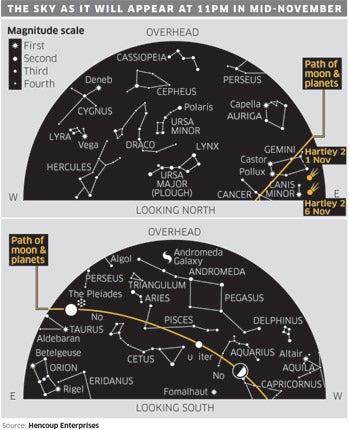The Stars: November

The barren skies of late autumn are with us again.
Centre-stage of this month's constellations is Pegasus. How the ancients configured a square of four stars into a flying horse is almost beyond comprehension. But there was method in their madness. Our ancestors "mapped" treasured stories and legends on to the heavens as an aide-memoire for farmers and sailors to recognise the stars. And the autumn skies are a celestial storybook.
The straggly line of stars to the left of Pegasus could hardly look less like a princess chained to a rock on the shore, about to suffer death at the hands of a sea monster. But that's how the ancients saw Andromeda. She was the daughter of Cassiopeia, the queen of Ethiopia, and her drippy husband, Cepheus. Cassiopeia is a striking W-shaped pattern, while nearby Cepheus is a dim, nondescript shape.
Cassiopeia claimed to Poseidon – the god of the sea – that her daughter was more beautiful than all the sea nymphs. An enraged Poseidon sent a sea monster, Cetus, to ravage her lands. You can see Cetus below Pegasus in the sky: a dim straggle of stars but – to our ancestors – a monster rearing above the horizon. Desperate, Cassiopeia and Cepheus consulted the oracle, whose advice was to sacrifice Andromeda to the monster. Which is how Andromeda happened to be chained to a rock. But everyone reckoned without Perseus, a bright constellation, next to Cassiopeia. Perseus was flying back from killing the gorgon Medusa, a glance at whose face, ringed with writhing serpents, would turn any onlooker to stone.
You can see the gorgon's head in the constellation of Perseus as the variable star Algol. Perseus soared over Ethiopian airspace when he spotted the damsel in distress. Andromeda was seconds from being devoured by Cetus. Swooping down, Perseus whipped Medusa's head out of its bag. In a trice, the beast was turned to stone, and Perseus unleashed the hapless maiden from her bonds. The pair married and lived happily ever after.
What's up
In the first week of November, it's your last chance to spot Comet Hartley 2, which is fading as it moves away from us. If you'd rather not brave the cold, look out for media coverage of pictures from Nasa's Epoxi spacecraft. On 4 November, it will fly past the icy nucleus of Comet Hartley 2, and should send back great close-up views. Debris from another comet, Tempel-Tuttle, will rain into our atmosphere on 17 and 18 November and burn up as the annual Leonid meteor shower. Jupiter is putting on a great show in the south-western sky. During the evening, you'll find the "winter constellations" rising in the east: the hunter Orion, with his adversary Taurus (the bull) and the twins, Castor and Pollux, in the constellation Gemini. Saturn rises in the east around 3am. From mid-month onwards, you'll find Venus in the morning sky before sunrise.
Diary
6: 4.52am New Moon
13: 4.38pm Moon at First Quarter
17/18: Maximum of Leonid meteor shower
21: 5.27 pm Full Moon
28: 8.36 pm Moon at Last Quarter
Subscribe to Independent Premium to bookmark this article
Want to bookmark your favourite articles and stories to read or reference later? Start your Independent Premium subscription today.

Join our commenting forum
Join thought-provoking conversations, follow other Independent readers and see their replies